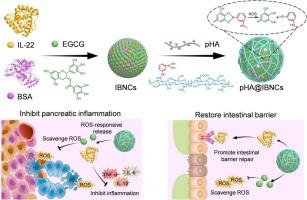当前位置:
X-MOL 学术
›
J. Control. Release
›
论文详情
Our official English website, www.x-mol.net, welcomes your
feedback! (Note: you will need to create a separate account there.)
Nanotherapeutics-mediated restoration of pancreatic homeostasis and intestinal barrier for the treatment of severe acute pancreatitis
Journal of Controlled Release ( IF 10.5 ) Pub Date : 2024-11-17 , DOI: 10.1016/j.jconrel.2024.11.022 Juanhui Lin, Yuansong Wei, Xiaxian Gu, Miaoru Liu, Mengru Wang, Renxiang Zhou, Duowu Zou, Lichen Yin, Chunhua Zhou, Duanmin Hu
Journal of Controlled Release ( IF 10.5 ) Pub Date : 2024-11-17 , DOI: 10.1016/j.jconrel.2024.11.022 Juanhui Lin, Yuansong Wei, Xiaxian Gu, Miaoru Liu, Mengru Wang, Renxiang Zhou, Duowu Zou, Lichen Yin, Chunhua Zhou, Duanmin Hu

|
Severe acute pancreatitis (SAP) is an inflammatory disease of the pancreas accompanied with intestinal injury, and effective therapeutic modalities are still highly lacking. Herein, a facile and effective nanotherapeutics (pHA@IBNCs) is developed to alleviate pancreatic inflammation and restore intestinal barrier for SAP treatment. Epigallocatechin gallate (EGCG, an anti-oxidant), interleukin-22 (IL-22, an anti-inflammatory and epithelial barrier-protecting cytokine), and bovine serum albumin (a framework protein), are assembled via non-covalent interactions to form nanocomplexes (IBNCs). Then, phenylboronic acid-modified hyaluronic acid (pHA) is synthesized and coated onto IBNCs via formation of the reversible boronate ester bonds to obtain pHA@IBNCs. Upon intravenous injection, pHA@IBNCs could efficiently accumulate at the lesion sites of sodium taurocholate (STC)-induced SAP mice, based on their prolonged blood circulation time and pHA-mediated targeting of activated intestinal epithelial cells and macrophages. Inside the inflammatory microenvironment, over-produced reactive oxygen species (ROS) trigger the shedding of the pHA layer and release of the drug payloads. Thereby, EGCG cooperates with IL-22 to attenuate pancreatitis and restore the intestinal barrier by scavenging ROS, suppressing pro-inflammatory cytokines secretion, and promoting the repair of intestinal epithelia. Such a nano-therapeutic approach targeting multiple pathological events may serve as a promising paradigm for the effective management of SAP.
中文翻译:

纳米治疗学介导的胰腺稳态和肠道屏障恢复治疗重症急性胰腺炎
严重急性胰腺炎 (SAP) 是一种伴有肠道损伤的胰腺炎症性疾病,目前仍极缺乏有效的治疗方式。在此,开发了一种简单有效的纳米疗法 (pHA@IBNCs) 来缓解胰腺炎症并恢复 SAP 治疗的肠道屏障。表没食子儿茶素没食子酸酯(EGCG,一种抗氧化剂)、白细胞介素-22(IL-22,一种抗炎和上皮屏障保护细胞因子)和牛血清白蛋白(一种框架蛋白)通过非共价相互作用组装形成纳米复合物 (IBNC)。然后,合成苯硼酸改性的透明质酸 (pHA) 并通过形成可逆硼酸酯键包被到 IBNC 上以获得pHA@IBNCs。静脉注射后,pHA@IBNCs可以有效地积聚在牛磺胆酸钠 (STC) 诱导的 SAP 小鼠的病变部位,基于其延长的血液循环时间和 pHA 介导的对活化肠上皮细胞和巨噬细胞的靶向。在炎症微环境中,过量产生的活性氧 (ROS) 会触发 pHA 层的脱落和药物有效载荷的释放。因此,EGCG 与 IL-22 合作,通过清除 ROS、抑制促炎细胞因子分泌和促进肠上皮细胞修复来减轻胰腺炎并恢复肠道屏障。这种针对多种病理事件的纳米治疗方法可能成为有效管理 SAP 的一种有前途的范式。
更新日期:2024-11-17
中文翻译:

纳米治疗学介导的胰腺稳态和肠道屏障恢复治疗重症急性胰腺炎
严重急性胰腺炎 (SAP) 是一种伴有肠道损伤的胰腺炎症性疾病,目前仍极缺乏有效的治疗方式。在此,开发了一种简单有效的纳米疗法 (pHA@IBNCs) 来缓解胰腺炎症并恢复 SAP 治疗的肠道屏障。表没食子儿茶素没食子酸酯(EGCG,一种抗氧化剂)、白细胞介素-22(IL-22,一种抗炎和上皮屏障保护细胞因子)和牛血清白蛋白(一种框架蛋白)通过非共价相互作用组装形成纳米复合物 (IBNC)。然后,合成苯硼酸改性的透明质酸 (pHA) 并通过形成可逆硼酸酯键包被到 IBNC 上以获得pHA@IBNCs。静脉注射后,pHA@IBNCs可以有效地积聚在牛磺胆酸钠 (STC) 诱导的 SAP 小鼠的病变部位,基于其延长的血液循环时间和 pHA 介导的对活化肠上皮细胞和巨噬细胞的靶向。在炎症微环境中,过量产生的活性氧 (ROS) 会触发 pHA 层的脱落和药物有效载荷的释放。因此,EGCG 与 IL-22 合作,通过清除 ROS、抑制促炎细胞因子分泌和促进肠上皮细胞修复来减轻胰腺炎并恢复肠道屏障。这种针对多种病理事件的纳米治疗方法可能成为有效管理 SAP 的一种有前途的范式。


















































 京公网安备 11010802027423号
京公网安备 11010802027423号